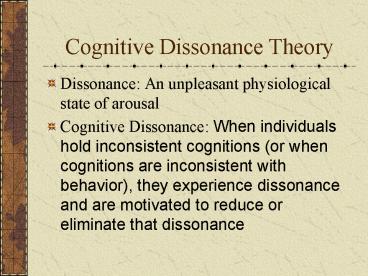Cognitive Dissonance Theory - PowerPoint PPT Presentation
1 / 16
Title:
Cognitive Dissonance Theory
Description:
Cognitive Dissonance Theory. Dissonance: An unpleasant physiological state of arousal. Cognitive Dissonance: When individuals hold inconsistent cognitions (or when ... – PowerPoint PPT presentation
Number of Views:613
Avg rating:3.0/5.0
Title: Cognitive Dissonance Theory
1
Cognitive Dissonance Theory
- Dissonance An unpleasant physiological state of
arousal - Cognitive Dissonance When individuals hold
inconsistent cognitions (or when cognitions are
inconsistent with behavior), they experience
dissonance and are motivated to reduce or
eliminate that dissonance
2
(No Transcript)
3
Five easy ways to reduce dissonance
- Change one of the inconsistent cognitions
(attitudes) - Change behavior or perceptions of behavior
- Add consonant cognitions
- Minimize importance of conflict
- Reduce degree of perceived choice
4
Types of dissonance effects
- Insufficient Justification
- Festinger and Carlsmith (1959)
- Insufficient Deterrence/Punishment
- Aronson and Carlsmith (1963)
- Justifying Difficult Decisions (Postdecisional
Dissonance) - Brehm (1956)
- Justification of Effort
- Aronson and Mills (1959)
5
(No Transcript)
6
Attribution Theory
- Attribution theory is the study of how people
explain the causes of their own and other
people's behavior. - Heider Personal vs. Situational attributions
- Behavior engulfs the field People prefer
personal attributions
7
Correspondence Bias
- Correspondence Bias The tendency to expect
peoples behavior to agree with their
dispositions - Jones Harris (1967)
- Ross, Amabile, and Steinmetz (1977)
- Gilbert Jones (1986)
8
(No Transcript)
9
Explanations of Correspondence Bias Cognitive
processes
- Attributions are a two step process
- Characterization Infer the persons dispositions
correspond to their behavior - Correction Adjust your initial inference for
situational constraint information - Characterization is relatively automatic
Correction is relatively effortful. - If Correction does not occur, attributions show
correspondence bias.
10
(No Transcript)
11
- Cognitive busyness When your mind is occupied
with something else, you might not have enough
resources to think about your attributions. - Gilbert, Pelham and Krull (1988).
12
Explanations of Correspondence Bias Motivation
- The need for prediction and control increases
personal attributions - Learned helplessness and attributions
13
(No Transcript)
14
Explanations of Correspondence Bias Salience
- Salience Behavior engulfs the field (Heider),
and the most salient aspect of the perceptual
field is likely to be viewed as having more
causal power. - Storms (1973)
15
(No Transcript)
16
Attribution and Stereotyping
- Stereotypes Cognitive schemas that allow for
easy and efficient organization of information
about people based on their membership in certain
groups - Self-fulfilling prophecies People tend to behave
in ways that confirm their own or others
expectations































